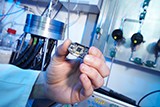Sep 2 2015
Smoke detectors are everywhere, but still thousands of people die in fires annually. Fire gas detectors, which detect carbon monoxide and nitrogen oxide, identify fires at an early stage. Thanks to a new measurement principle developed by Fraunhofer researchers, these costly sensors will soon be inexpensive and ready for the mass market.
 In Fraunhofer IPM�s sensor, dyes react to gases � and trigger an alarm, even in the case of smoldering fires. � K.-U. Wudtke/Fraunhofer IPM
In Fraunhofer IPM�s sensor, dyes react to gases � and trigger an alarm, even in the case of smoldering fires. � K.-U. Wudtke/Fraunhofer IPM
As the stars twinkle in the sky high above the house, people lie sleeping in their beds. It’s just an ordinary night – and yet, on this night, the slumberers’ lives are at stake: A cable is smoldering away and poisonous carbon monoxide spreads unnoticed through the room. The smoke detector doesn’t sound the alarm because it responds only to smoke, which is not always produced in a smoldering fire. In short, the room’s occupants are in great danger.
Reliably detects carbon monoxide
Gas sensors could wake people in time and save their lives. Researchers at the Fraunhofer Institute for Physical Measurement Techniques IPM in Freiburg have developed just such a sensor. It recognizes a fire not by its smoke but by the carbon monoxide it emits. Nitrogen dioxide, which is produced a little later in the course of the fire, also triggers the alarm. Even the tiniest amounts of these gases suffice. “The sensors are extremely sensitive, so they respond very early in the fire’s development. After all, every second counts,” explains Dr. Carolin Pannek, a researcher at the IPM.
Life-saving carbon-monoxide sensors of this kind are already available today, but they are too expensive for the mass market. Furthermore, they require maintenance and use a lot of electricity. Commercially available semiconductor gas sensors are cheaper, but can’t distinguish between different gases. That’s not the case with the new sensor type created by the IPM researchers. “Ours responds only to carbon monoxide and nitrogen dioxide – it ignores other gases. By using roll-to-roll processing, we can produce the sensors very inexpensively, making it affordable for consumers,” confirms Pannek.
This is primarily thanks to the dyes at the core of the sensor. Just as a lock opens only with a specific key, each dye responds only to a specific gas. Thus the sensor contains one dye for carbon monoxide and another for nitrogen dioxide. It works by having a small LED shine blue light into a waveguide coated with a polymer into which the dyes have been mixed. The light travels in a zigzag path to the other end of the waveguide, where it meets up with a detector. If the air in the room is normal, the coating glows purple – which means it absorbs only a small amount of blue light and lets most of the blue light reach the detector. If however there is carbon monoxide in the air, the dye glows yellow. The yellow dye absorbs more blue light – so the overall amount of light reaching the detector is lower. Below a given threshold value this trips the alarm. To detect nitrogen oxide, the researchers include a second waveguide coated with another dye.
Costs slightly more than a smoke detector
The researchers were careful to ensure that the sensor could be manufactured cost-effectively in bulk – after all, no one wants to dig much deeper in their pocket than they would for a conventional smoke detector, even though gas sensors offer significantly more protection. “When mass produced, the sensors will cost about the same as smoke detectors – and significantly less than the fire gas detectors currently available,” Panneck believes.
To make their fire gas sensors, the researchers use the same components found in smoke detectors and supplement them with the optical waveguides. The electronics determine the threshold at which the sensor should sound the alarm. To manufacture these components, the researchers have worked together with an industry partner to develop a roll-to-roll process similar to newspaper printing that is capable of printing 15,000 measurement systems on a continuous roll. The process is both suitable for mass production and cost effective. But it will certainly take a few years for the gas sensors to become as ubiquitous in living and bedrooms as smoke detectors are now.